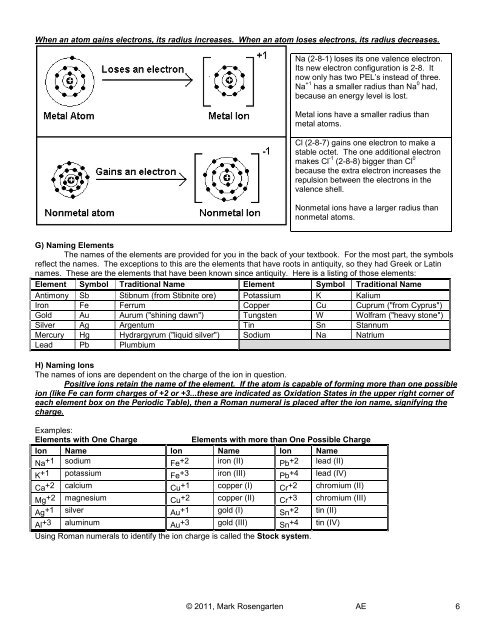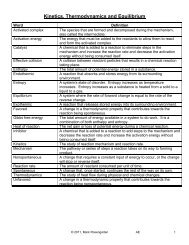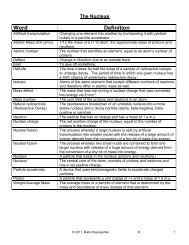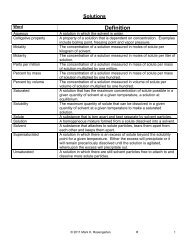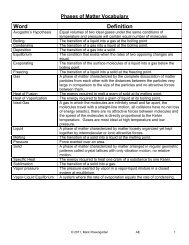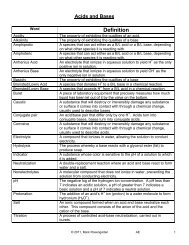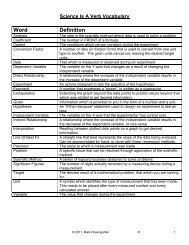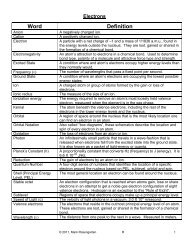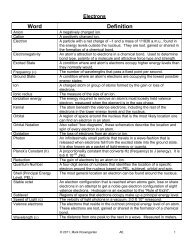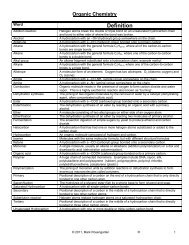Unit 6: Periodic Table and Bonding - Mark Rosengarten
Unit 6: Periodic Table and Bonding - Mark Rosengarten
Unit 6: Periodic Table and Bonding - Mark Rosengarten
You also want an ePaper? Increase the reach of your titles
YUMPU automatically turns print PDFs into web optimized ePapers that Google loves.
When an atom gains electrons, its radius increases. When an atom loses electrons, its radius decreases.<br />
Na (2-8-1) loses its one valence electron.<br />
Its new electron configuration is 2-8. It<br />
now only has two PEL’s instead of three.<br />
Na +1 has a smaller radius than Na 0 had,<br />
because an energy level is lost.<br />
Metal ions have a smaller radius than<br />
metal atoms.<br />
Cl (2-8-7) gains one electron to make a<br />
stable octet. The one additional electron<br />
makes Cl -1 (2-8-8) bigger than Cl 0<br />
because the extra electron increases the<br />
repulsion between the electrons in the<br />
valence shell.<br />
Nonmetal ions have a larger radius than<br />
nonmetal atoms.<br />
G) Naming Elements<br />
The names of the elements are provided for you in the back of your textbook. For the most part, the symbols<br />
reflect the names. The exceptions to this are the elements that have roots in antiquity, so they had Greek or Latin<br />
names. These are the elements that have been known since antiquity. Here is a listing of those elements:<br />
Element Symbol Traditional Name Element Symbol Traditional Name<br />
Antimony Sb Stibnum (from Stibnite ore) Potassium K Kalium<br />
Iron Fe Ferrum Copper Cu Cuprum ("from Cyprus")<br />
Gold Au Aurum ("shining dawn") Tungsten W Wolfram ("heavy stone")<br />
Silver Ag Argentum Tin Sn Stannum<br />
Mercury Hg Hydrargyrum ("liquid silver") Sodium Na Natrium<br />
Lead Pb Plumbium<br />
H) Naming Ions<br />
The names of ions are dependent on the charge of the ion in question.<br />
Positive ions retain the name of the element. If the atom is capable of forming more than one possible<br />
ion (like Fe can form charges of +2 or +3...these are indicated as Oxidation States in the upper right corner of<br />
each element box on the <strong>Periodic</strong> <strong>Table</strong>), then a Roman numeral is placed after the ion name, signifying the<br />
charge.<br />
Examples:<br />
Elements with One Charge<br />
Elements with more than One Possible Charge<br />
Ion Name Ion Name Ion Name<br />
Na +1 sodium Fe +2 iron (II) Pb +2 lead (II)<br />
K +1 potassium Fe +3 iron (III) Pb +4 lead (IV)<br />
Ca +2 calcium Cu +1 copper (I) Cr +2 chromium (II)<br />
Mg +2 magnesium Cu +2 copper (II) Cr +3 chromium (III)<br />
Ag +1 silver Au +1 gold (I) Sn +2 tin (II)<br />
Al +3 aluminum Au +3 gold (III) Sn +4 tin (IV)<br />
Using Roman numerals to identify the ion charge is called the Stock system.<br />
© 2011, <strong>Mark</strong> <strong>Rosengarten</strong> AE 6


